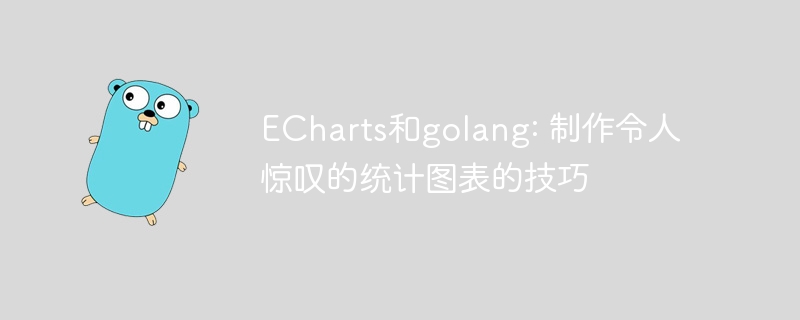

ECharts and golang: Tips for making stunning statistical charts, concrete code examples required
Introduction:
In the modern data-driven world, statistics Charts are an important tool for presenting data and discovering trends. ECharts is an open source visualization library based on JavaScript. It provides a wealth of chart types and interactive functions that can help us create a variety of stunning statistical charts. Golang is an efficient and concise programming language. It provides powerful back-end programming capabilities and can be used in conjunction with ECharts to create more flexible and feature-rich chart applications. This article will introduce some techniques for making stunning statistical charts using ECharts and golang, and give specific code examples.
1. Introduction to ECharts
ECharts is a JavaScript-based open source visualization library developed by Baidu’s front-end team. It provides a variety of chart types, including line charts, bar charts, pie charts, radar charts, etc. It also supports chart interaction, such as dragging, zooming, switching and other functions. Using ECharts, we can quickly create beautiful, highly interactive statistical charts. The following is a simple example of using ECharts to draw a bar chart:
// 引入echarts库
import echarts from 'echarts';
// 初始化一个echarts实例
var myChart = echarts.init(document.getElementById('chartContainer'));
// 定义图表配置项
var option = {
// x轴数据
xAxis: {
type: 'category',
data: ['Mon', 'Tue', 'Wed', 'Thu', 'Fri', 'Sat', 'Sun']
},
// y轴数据
yAxis: {
type: 'value'
},
// 数据
series: [{
data: [120, 200, 150, 80, 70, 110, 130],
type: 'bar'
}]
};
// 使用配置项绘制图表
myChart.setOption(option);This code uses ECharts to draw a simple bar chart. The x-axis represents the day of the week, the y-axis represents the sales volume, and the bar chart represents the daily sales. data.
2. Combination of golang and ECharts
golang is a powerful back-end programming language. It can be used in combination with ECharts to process data through the back-end of golang and pass the processing results to ECharts to achieve Dynamic and real-time statistical charts. The following is an example of using golang and ECharts to create a real-time line chart:
package main
import (
"encoding/json"
"log"
"net/http"
"time"
)
func main() {
// 启动一个HTTP服务器
http.HandleFunc("/data", handleData)
http.Handle("/", http.FileServer(http.Dir("public")))
go http.ListenAndServe(":8080", nil)
// 模拟实时数据更新
for {
time.Sleep(time.Second * 5)
updateData()
}
}
func handleData(w http.ResponseWriter, r *http.Request) {
// 构造数据
data := []struct {
Time int64 `json:"time"`
Value int `json:"value"`
}{
{time.Now().Unix(), 100},
{time.Now().Unix(), 150},
{time.Now().Unix(), 120},
{time.Now().Unix(), 170},
}
// 将数据转换为JSON格式
jsonData, err := json.Marshal(data)
if err != nil {
log.Fatal(err)
}
// 设置响应头
w.Header().Set("Content-Type", "application/json")
// 返回数据
w.Write(jsonData)
}
func updateData() {
// 省略实时数据的更新逻辑
}This code first starts an HTTP server and listens to port 8080. When accessing /data, real-time data will be returned. And http.Handle("/", http.FileServer(http.Dir("public"))) provides static file service and can store the front-end code in the public folder.
In the front-end code, use Ajax to get the latest data from /data every 5 seconds and update the line chart. For specific ECharts code and front-end processing logic, please refer to the ECharts introduction section above.
Through the combination of golang and ECharts, we can process real-time data and display the processing results in statistical charts in real time, bringing better interaction and experience to users.
Conclusion:
ECharts and golang are a powerful combination that can help us create stunning statistical charts. Through ECharts, we can easily create various types of charts, and use golang to implement back-end data processing and real-time updates to display richer chart content to users. We hope that through the introduction and sample code of this article, readers can master the skills of using ECharts and golang to create statistical charts, and further improve their data display and analysis capabilities.
The above is the detailed content of ECharts and golang: Tips for making stunning statistical charts. For more information, please follow other related articles on the PHP Chinese website!




